Living Like Popes in Avignon, France
It was mid-February and my friend Melissa and I were not amused with how the Galician winter had been treating us. Dark skies and rainy nights kept us indoors most of the time, and because of high humidity, the cold temperatures were particularly bitter despite never dropping below freezing. Simply put, we needed to get out, and sunny southern France seemed like a great place to escape from Santiago for a long weekend.
So why Avignon and not, say, Marseille, or any of the fine provincial capitals scattered around Provence? Well, for one, it was centrally located between the airport and all the places we wanted to make daytrips to: Arles, Nîmes, and the Pont du Gard. But to be honest, the main reason we chose Avignon had to do with the existence of a hostel, which are far and few between in a region that isn’t necessarily on the backpacker trail. Call us cheapskates, but there’s no need to pay 40€ a night for crappy hotel rooms when 20€ bunkbeds work just fine. (Pop’ Hostel, by the way, is worth looking into if you’re planning a trip here!)
In the end, Avignon (pronounced “ah-vee-nyon” [a.vi.ɲɔ̃]) turned out to be a great home base for exploring southern France. We were never more than an hour away from our daytrip destinations via efficient TER trains or intercity buses, and there were plenty of cafés, bakeries, mini-markets, and restaurants in the old town, giving us a plethora of options to choose from for our pre-train breakfasts and evening dinners once we were back in town.
I’m sure you’re wondering, now why did the bishop of Rome leave his post for southern France? There’s not enough room on this post to get into the intricacies of late-medieval church-state relations (“thank GOD” I’m sure some of you are saying), but safe to say, King Philip IV of France was not happy when Pope Boniface VIII asserted in his bull Unam sanctam that all temporal rulers were to be subject to the pope, the supreme spiritual ruler.
At the time, the pope himself was basically a king in his own right, ruling vast swaths of central Italy, waging wars, and owning estates across Italy and France—one of which was the Comtat Venaissin, home to Avignon.
By 1305, however, a Frenchman was elected to the papacy: Clement V, who had been the archbishop of Bordeaux. He was actually crowned in Lyons, rather than Rome, and ended up permanently moving the papal curia to Avignon to get away from the political quarrels rocking Rome at the time (and to get right next door to King Philip’s territory). As the century grew on, though, the popes gained a reputation for being essentially pawns in the king of France’s hand, so this period of church history became known as the “Babylonian Captivity,” hearkening back to when the Jews were exiled to Babylon in the 500s BCE.
En route from Santiago to the former home of the popes, Melissa and I actually ran into a group of Galician highschoolers at the Marseille airport’s train station! We overheard some of the students speaking in Galician (and generally being loud Spaniards), so we struck up a conversation with some of the teachers and were pleasantly surprised to learn they were from a village not far from Santiago. Cue declarations of “¡el mundo es un pañuelo!” and “what a small world we live in!”…
The popes have long since returned to the walls of the Vatican in Rome, where Pope Francis lives today. But even though they packed their bags and left Avignon at the end of the 1300s, there still remained a gargantuan reminder of their sojourn in southern France: the Papal Palace. More military fortress than a spiritual sanctuary, the Palais des Papes endures as one of the largest Gothic buildings in the world.
The palace complex is centered on two main courtyards, around which rise up impregnable walls that are buttressed by thick, heavy arches. A far cry from the idealized, five-pointed citadels later constructed in early modern Europe, the Papal Palace was rather haphazardly put together during the 14th century; a large expansion branches off to the north to meet the cathedral and defensive towers bud out at every other corner. Secret passageways connect dining halls with dungeons, stairs wind between soaring spaces and tiny bedrooms, and a small flock of windows stare out at the city beyond…and the crumbling courtyards within.
One of the most vivid images I remember from my college world history survey course has to do with Pope Clement VI. He reigned in Avignon mid-century and rode out the Black Plague by locking himself within the palace, where he set multiple bonfires raging day and night to protect against the “bad air.” Apparently this method worked, and when I finally visited in person, it was riveting to cross beneath the portcullis and imagine the great, roaring fires that would have been set up in the central Cour d’Honneur.
Think of the grandeur of St. Peter’s Basilica and you’ll have an idea of how opulent this palace would have been in its heyday. Today the vast, empty stone halls and chambers seem cold and almost spooky, but when the Pope resided here, hand-woven tapestries and brilliant, colorful frescoes would have illuminated the walls. Due to centuries of neglect, the palace’s former splendor has been lost to the past, but one small room still preserves its bright blue frescoes.
During the French Revolution, the papal palace became a military barracks, and it’s not hard to see why: long battlements connect lookout towers, the thick foundations had protected those within from attacks for years, and the whole structure sits on a defensive, rocky outcropping overlooking the Rhône River. Fortunately for Melissa and me, the upper parapets were open for access, so we were able to get panoramic views of charming Avignon.
Apart from the monumental palace, there’s not much else to “see” in Avignon, although native French speakers get a kick out of the ruins of a medieval bridge that once spanned the Rhône, as the Pont d’Avignon features in a famous French nursery rhyme that will get stuck in your head—you’ve been warned.
Still, Avignon’s old town has been declared a World Heritage Site, so fortunately the city isn’t a one-hit wonder. The main shopping drag, Rue de la République, is lined with bourgeois Second Empire-style mansions. Place de l’Horloge is a typically French main square: the town hall and classy hotels surround a sea of terrace cafés, shade trees, a clock tower, and even a merry-go-round. Facing the Papal Palace, the Place du Palais is cinematic at night, when this empty square brings you face-to-face with the lit-up fortress. You’ll have to wade through some residential streets to get to it, but the petite Place des Corps-Saints opens up to a veritable food court of cozy bars and bistros. And to top it all off, a complete set of medieval walls wraps around the entire city—a rare sight in France!
Most mornings here, Melissa and I would get our carb and caffeine fix by simply wandering around (read: getting lost in) the old town’s maze of pastel-colored homes and limestone churches. One day we would stop off at a streetside bakery for croissants and brioches, the next day for almond-topped croissants and chocolate-filled bread. And in true French fashion, we would sit down while we sipped warm cups of coffee, be it an in-your-face shot of espresso, a cereal-bowl-sized café au lait, or a short, subtle, hazelnut-colored noisette.
One of our favorite finds from stumbling across the old town was the restaurant Ginette et Marcel, which opens out onto a tree-lined square, Place des Corps-Saints. The quaint interior reminded me of a Cracker Barrel crossed with a French grandmother’s house meets a trendy new bistro; the old-fashioned appliances, shabby chic décor, and antique finds gave a lot of character to this restaurant that Melissa and I would return to twice for dinner.
The down-to-earth folks at Ginette et Marcel specialize in unpretentious tartines—open face sandwiches—and also serve a tempting array of tartes—pies. Our first night in town, after much dithering and indecision, we resolved to try this place…and it was probably the best choice we made the whole trip. We split two tartines: the first was a fresh combination of pesto, tomato, and mozzarella, while the second was a sinful mix of potatoes, bacon, onions, and cheese. For dessert, we indulged our sweet tooths by splitting a mini raspberry pie, which I’m unable to describe in mere words.
As our final day in southern France drew to a close, we had dinner at Ginette et Marcel yet again, splitting three tartines to get a little bit of everything: toast spread with umami-rich terrine and topped with playful gherkins; another with cream cheese, smoked salmon, and capers; and most surprising of all, sweet prunes covered with melted bleu cheese. Our wallets were grateful that this restaurant upheld the French tradition of the carafe d’eau: a no-questions-asked, complimentary pitcher of water.
Unfortunately, just like the popes, it was time for us to return home. Whereas the late-medieval popes in all likelihood sailed safely back to Rome, a packed Ryanair flight was the cross we had to bear to get back to Santiago. The sights—and flavors—of Avignon, though, would linger in our minds in the weeks to come.
If you’re a French speaker, are you familiar with the Avignon jingle? What’s your favorite French dish? Tell me below in the comments!

We took a similar path that the Roman Catholic popes did in the 1300s, who were also fleeing an unsavory (political) climate. They left chaotic Rome for the security of Avignon, a major city along the Rhône River not far from the Mediterranean coast. We scored (and later endured) super-cheap Ryanair flights to Marseille’s airport and looked forward to encountering not only papal history but also Roman ruins and endless French pastries.
Why we used Avignon as a home base for the region
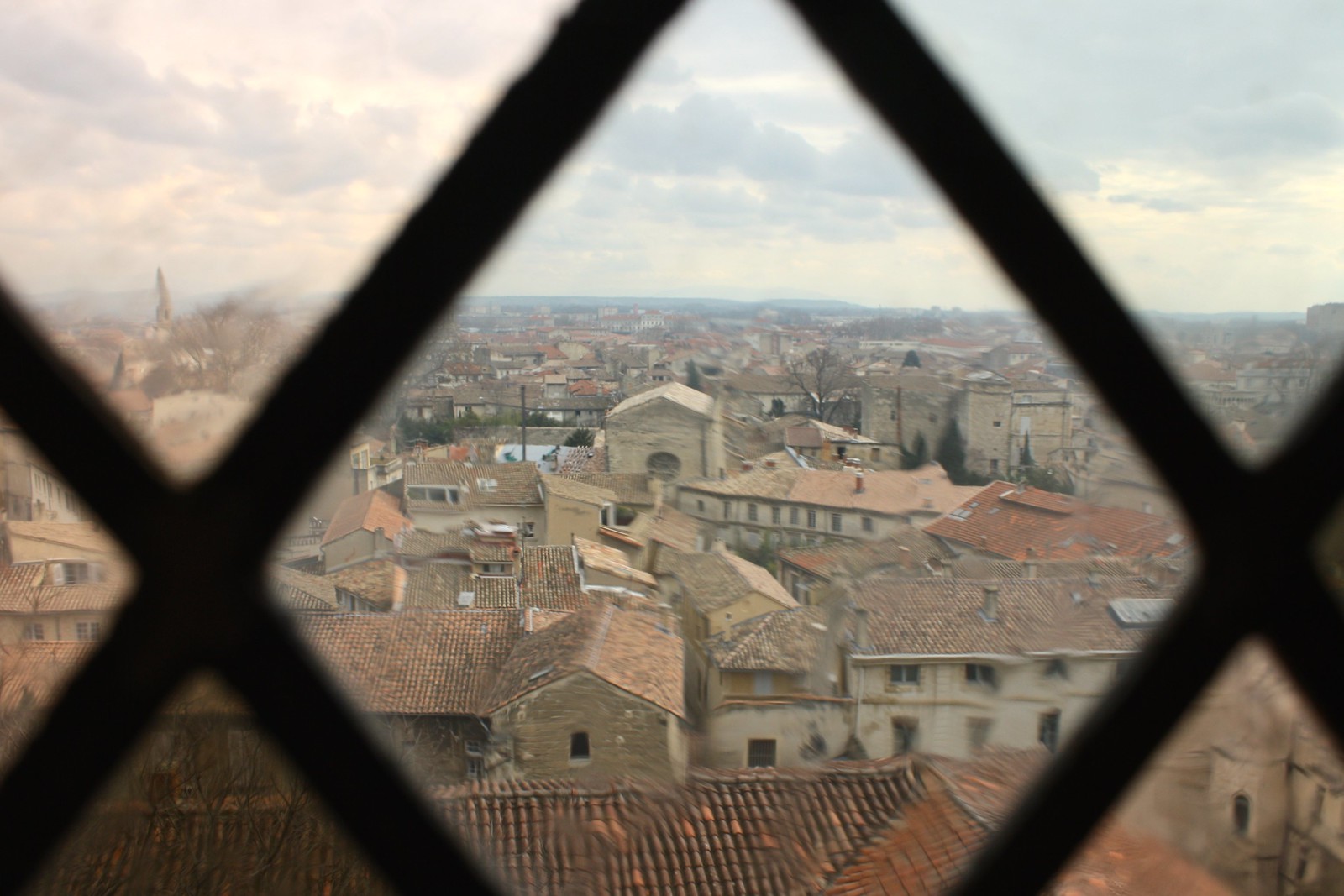 |
| The city seen through the windows of the Papal Palace |
So why Avignon and not, say, Marseille, or any of the fine provincial capitals scattered around Provence? Well, for one, it was centrally located between the airport and all the places we wanted to make daytrips to: Arles, Nîmes, and the Pont du Gard. But to be honest, the main reason we chose Avignon had to do with the existence of a hostel, which are far and few between in a region that isn’t necessarily on the backpacker trail. Call us cheapskates, but there’s no need to pay 40€ a night for crappy hotel rooms when 20€ bunkbeds work just fine. (Pop’ Hostel, by the way, is worth looking into if you’re planning a trip here!)
 |
| Window murals |
In the end, Avignon (pronounced “ah-vee-nyon” [a.vi.ɲɔ̃]) turned out to be a great home base for exploring southern France. We were never more than an hour away from our daytrip destinations via efficient TER trains or intercity buses, and there were plenty of cafés, bakeries, mini-markets, and restaurants in the old town, giving us a plethora of options to choose from for our pre-train breakfasts and evening dinners once we were back in town.
How the popes made their way here from Rome
 |
| The main square |
I’m sure you’re wondering, now why did the bishop of Rome leave his post for southern France? There’s not enough room on this post to get into the intricacies of late-medieval church-state relations (“thank GOD” I’m sure some of you are saying), but safe to say, King Philip IV of France was not happy when Pope Boniface VIII asserted in his bull Unam sanctam that all temporal rulers were to be subject to the pope, the supreme spiritual ruler.
At the time, the pope himself was basically a king in his own right, ruling vast swaths of central Italy, waging wars, and owning estates across Italy and France—one of which was the Comtat Venaissin, home to Avignon.
By 1305, however, a Frenchman was elected to the papacy: Clement V, who had been the archbishop of Bordeaux. He was actually crowned in Lyons, rather than Rome, and ended up permanently moving the papal curia to Avignon to get away from the political quarrels rocking Rome at the time (and to get right next door to King Philip’s territory). As the century grew on, though, the popes gained a reputation for being essentially pawns in the king of France’s hand, so this period of church history became known as the “Babylonian Captivity,” hearkening back to when the Jews were exiled to Babylon in the 500s BCE.
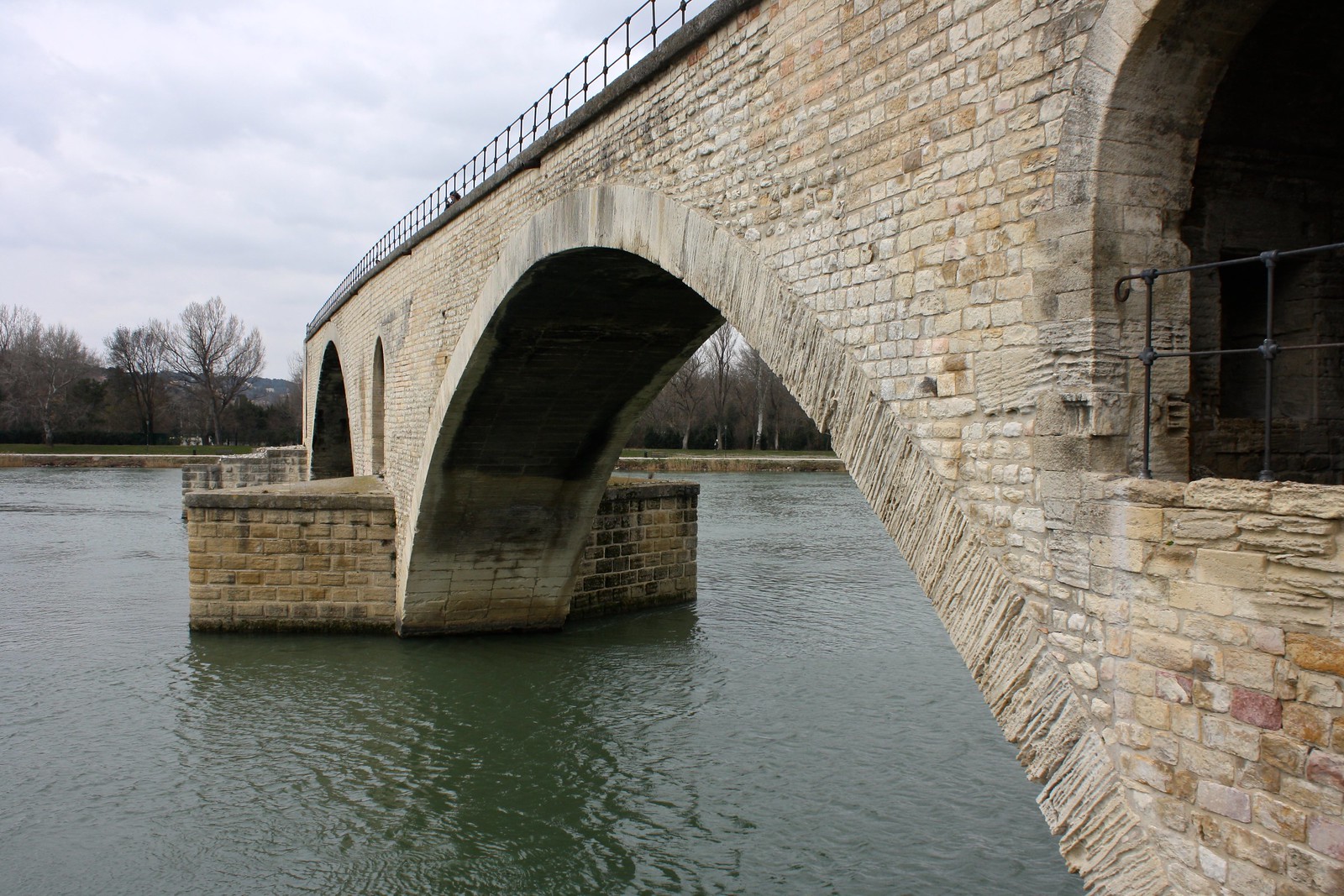 |
| The once-monumental St. Bénézet Bridge |
En route from Santiago to the former home of the popes, Melissa and I actually ran into a group of Galician highschoolers at the Marseille airport’s train station! We overheard some of the students speaking in Galician (and generally being loud Spaniards), so we struck up a conversation with some of the teachers and were pleasantly surprised to learn they were from a village not far from Santiago. Cue declarations of “¡el mundo es un pañuelo!” and “what a small world we live in!”…
Exploring the Papal Palace
 |
| Inside the Cour d’Honneur |
The popes have long since returned to the walls of the Vatican in Rome, where Pope Francis lives today. But even though they packed their bags and left Avignon at the end of the 1300s, there still remained a gargantuan reminder of their sojourn in southern France: the Papal Palace. More military fortress than a spiritual sanctuary, the Palais des Papes endures as one of the largest Gothic buildings in the world.
 |
| The audience hall |
The palace complex is centered on two main courtyards, around which rise up impregnable walls that are buttressed by thick, heavy arches. A far cry from the idealized, five-pointed citadels later constructed in early modern Europe, the Papal Palace was rather haphazardly put together during the 14th century; a large expansion branches off to the north to meet the cathedral and defensive towers bud out at every other corner. Secret passageways connect dining halls with dungeons, stairs wind between soaring spaces and tiny bedrooms, and a small flock of windows stare out at the city beyond…and the crumbling courtyards within.
 |
| Hopping around the parapet |
One of the most vivid images I remember from my college world history survey course has to do with Pope Clement VI. He reigned in Avignon mid-century and rode out the Black Plague by locking himself within the palace, where he set multiple bonfires raging day and night to protect against the “bad air.” Apparently this method worked, and when I finally visited in person, it was riveting to cross beneath the portcullis and imagine the great, roaring fires that would have been set up in the central Cour d’Honneur.
 |
| I wasn’t supposed to take this photo but I took it anyway |
Think of the grandeur of St. Peter’s Basilica and you’ll have an idea of how opulent this palace would have been in its heyday. Today the vast, empty stone halls and chambers seem cold and almost spooky, but when the Pope resided here, hand-woven tapestries and brilliant, colorful frescoes would have illuminated the walls. Due to centuries of neglect, the palace’s former splendor has been lost to the past, but one small room still preserves its bright blue frescoes.
During the French Revolution, the papal palace became a military barracks, and it’s not hard to see why: long battlements connect lookout towers, the thick foundations had protected those within from attacks for years, and the whole structure sits on a defensive, rocky outcropping overlooking the Rhône River. Fortunately for Melissa and me, the upper parapets were open for access, so we were able to get panoramic views of charming Avignon.
Enjoying (and getting hopelessly lost in) the old walled city
 |
| A quiet neighborhood street |
Apart from the monumental palace, there’s not much else to “see” in Avignon, although native French speakers get a kick out of the ruins of a medieval bridge that once spanned the Rhône, as the Pont d’Avignon features in a famous French nursery rhyme that will get stuck in your head—you’ve been warned.
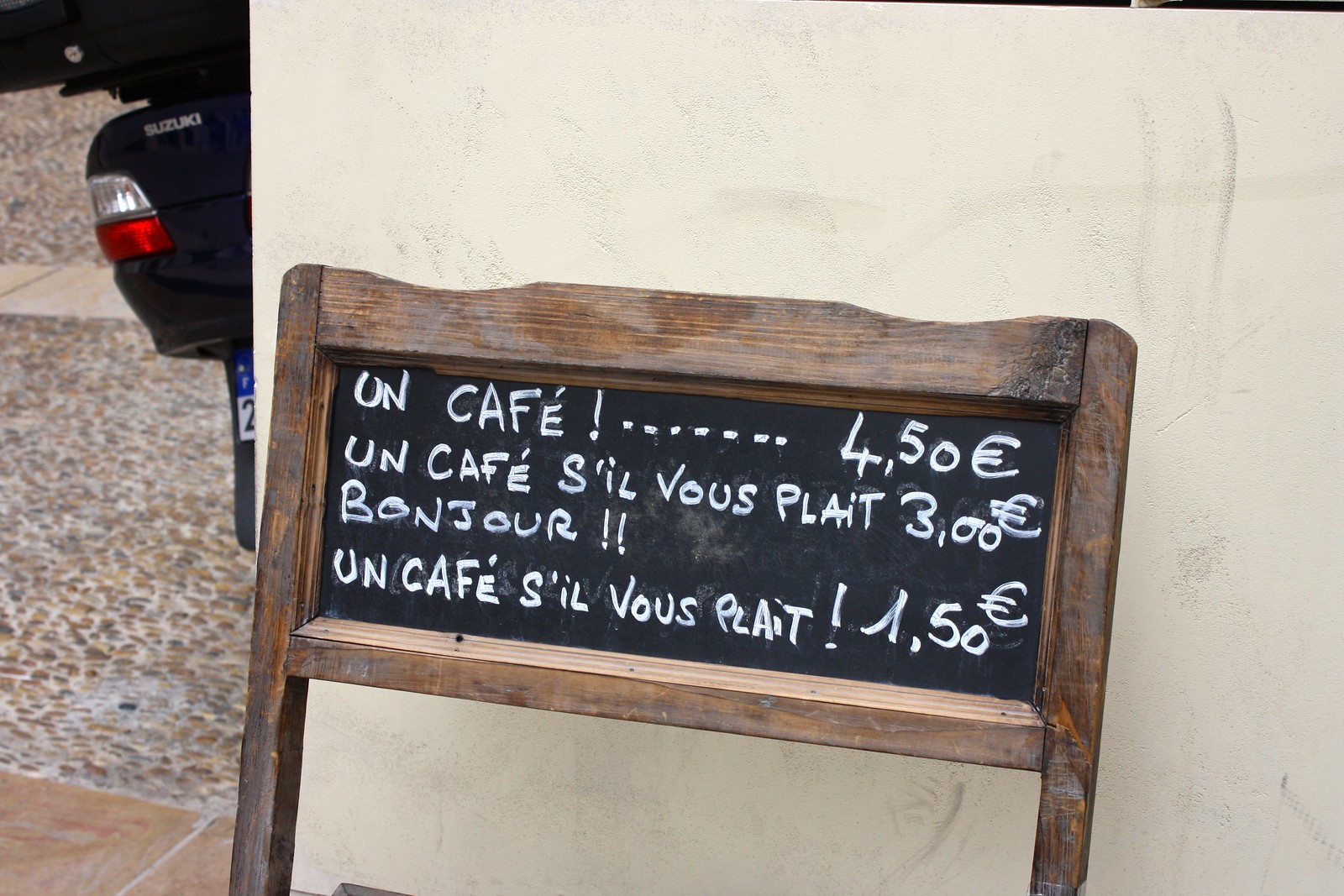 |
| The French love their manners |
Still, Avignon’s old town has been declared a World Heritage Site, so fortunately the city isn’t a one-hit wonder. The main shopping drag, Rue de la République, is lined with bourgeois Second Empire-style mansions. Place de l’Horloge is a typically French main square: the town hall and classy hotels surround a sea of terrace cafés, shade trees, a clock tower, and even a merry-go-round. Facing the Papal Palace, the Place du Palais is cinematic at night, when this empty square brings you face-to-face with the lit-up fortress. You’ll have to wade through some residential streets to get to it, but the petite Place des Corps-Saints opens up to a veritable food court of cozy bars and bistros. And to top it all off, a complete set of medieval walls wraps around the entire city—a rare sight in France!
 |
| The medieval city walls |
Most mornings here, Melissa and I would get our carb and caffeine fix by simply wandering around (read: getting lost in) the old town’s maze of pastel-colored homes and limestone churches. One day we would stop off at a streetside bakery for croissants and brioches, the next day for almond-topped croissants and chocolate-filled bread. And in true French fashion, we would sit down while we sipped warm cups of coffee, be it an in-your-face shot of espresso, a cereal-bowl-sized café au lait, or a short, subtle, hazelnut-colored noisette.
My new favorite restaurant: Ginette et Marcel
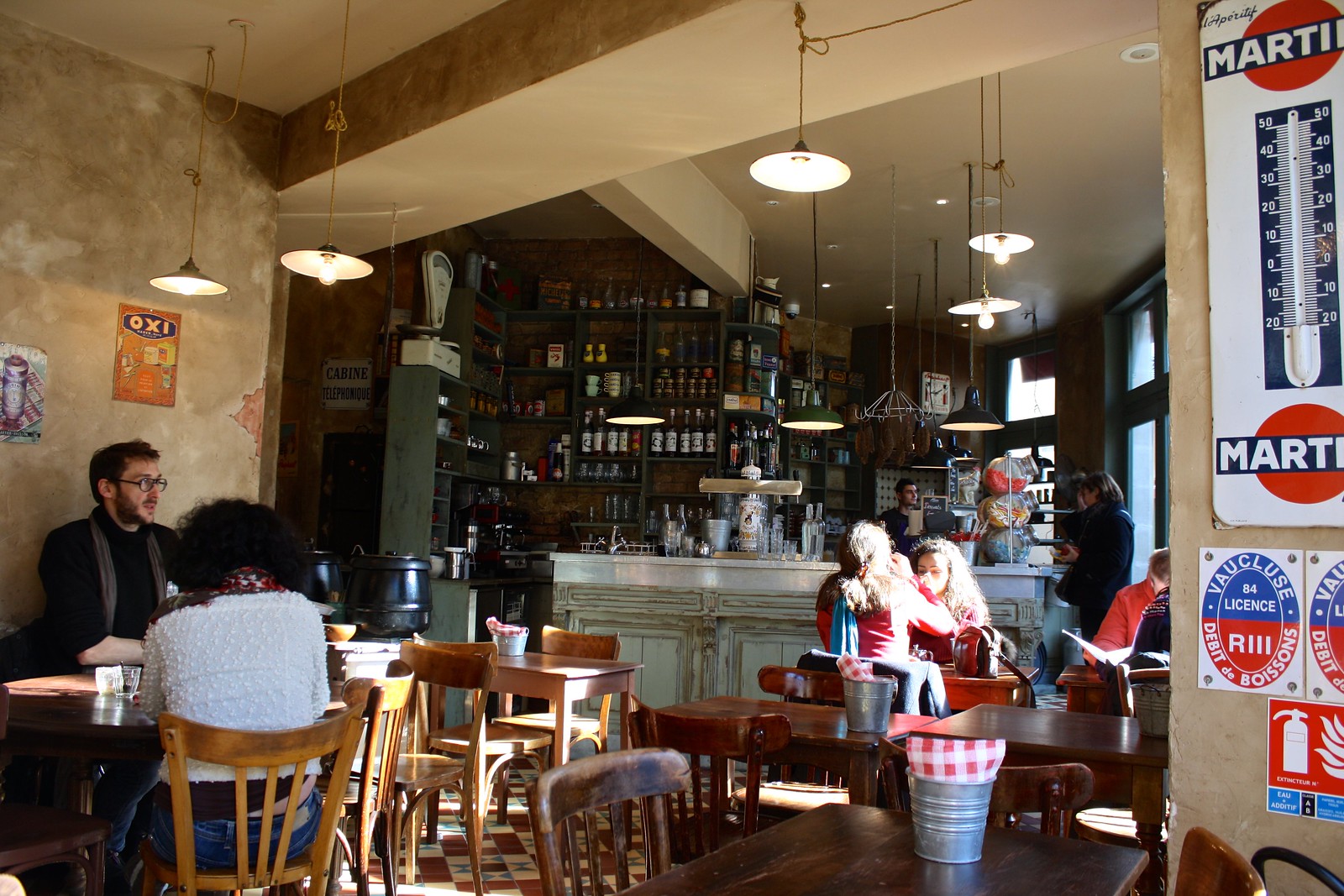 |
| The dining area |
One of our favorite finds from stumbling across the old town was the restaurant Ginette et Marcel, which opens out onto a tree-lined square, Place des Corps-Saints. The quaint interior reminded me of a Cracker Barrel crossed with a French grandmother’s house meets a trendy new bistro; the old-fashioned appliances, shabby chic décor, and antique finds gave a lot of character to this restaurant that Melissa and I would return to twice for dinner.
 |
| Terrine spread & gherkins |
The down-to-earth folks at Ginette et Marcel specialize in unpretentious tartines—open face sandwiches—and also serve a tempting array of tartes—pies. Our first night in town, after much dithering and indecision, we resolved to try this place…and it was probably the best choice we made the whole trip. We split two tartines: the first was a fresh combination of pesto, tomato, and mozzarella, while the second was a sinful mix of potatoes, bacon, onions, and cheese. For dessert, we indulged our sweet tooths by splitting a mini raspberry pie, which I’m unable to describe in mere words.
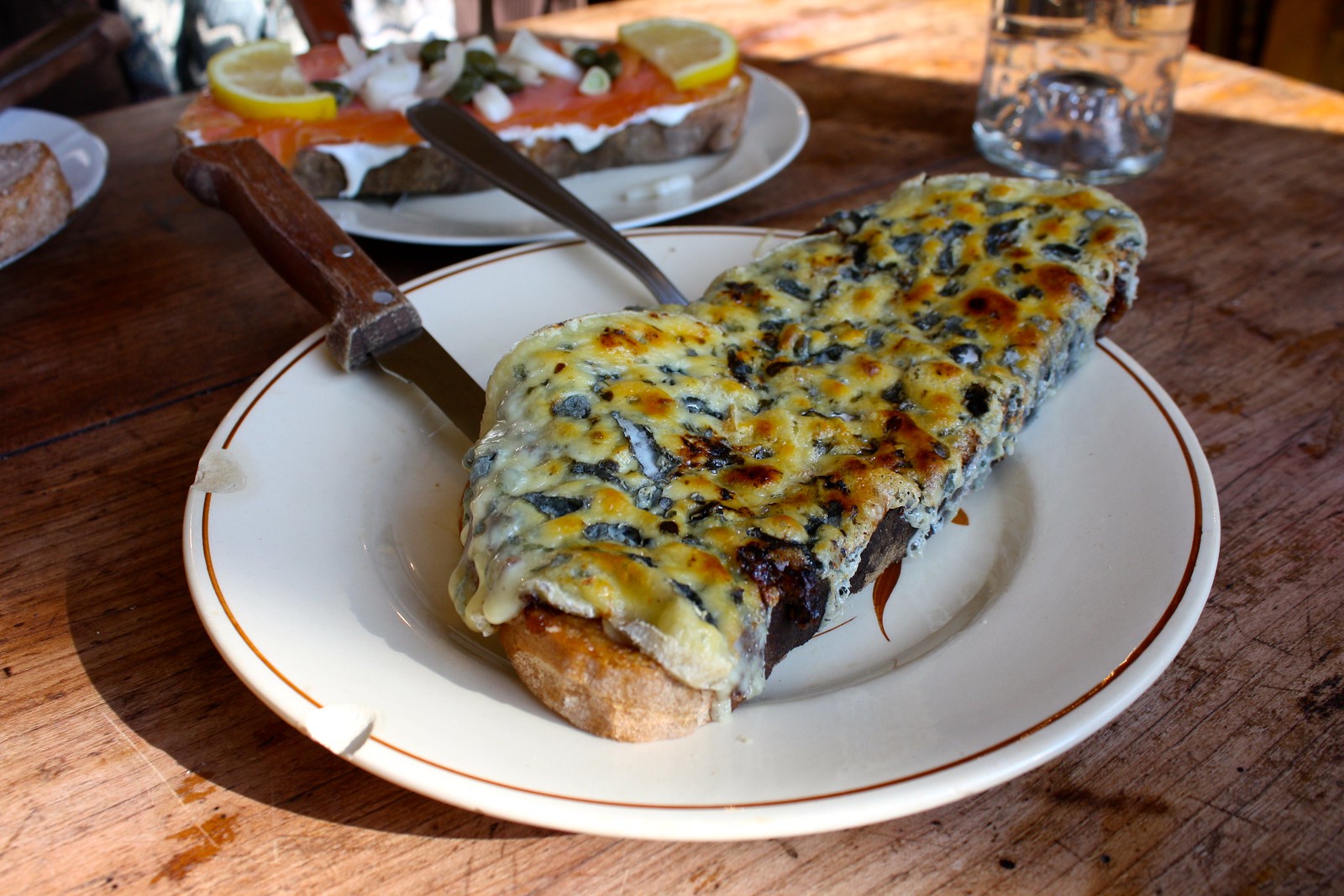 |
| Prunes & bleu cheese |
As our final day in southern France drew to a close, we had dinner at Ginette et Marcel yet again, splitting three tartines to get a little bit of everything: toast spread with umami-rich terrine and topped with playful gherkins; another with cream cheese, smoked salmon, and capers; and most surprising of all, sweet prunes covered with melted bleu cheese. Our wallets were grateful that this restaurant upheld the French tradition of the carafe d’eau: a no-questions-asked, complimentary pitcher of water.
Unfortunately, just like the popes, it was time for us to return home. Whereas the late-medieval popes in all likelihood sailed safely back to Rome, a packed Ryanair flight was the cross we had to bear to get back to Santiago. The sights—and flavors—of Avignon, though, would linger in our minds in the weeks to come.
If you’re a French speaker, are you familiar with the Avignon jingle? What’s your favorite French dish? Tell me below in the comments!
